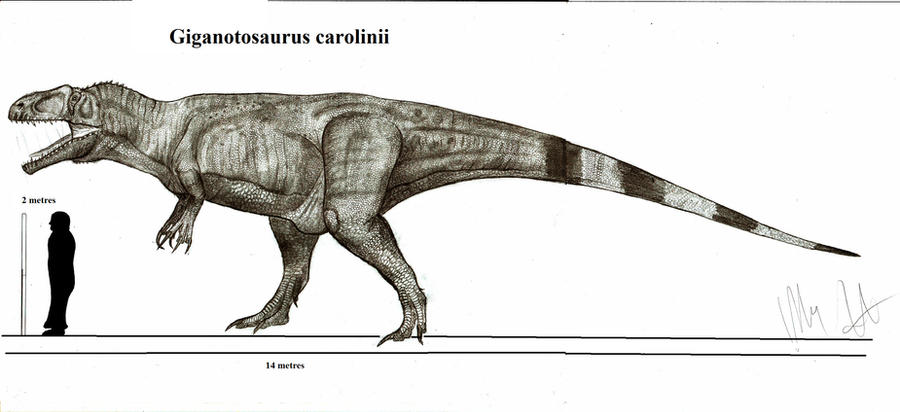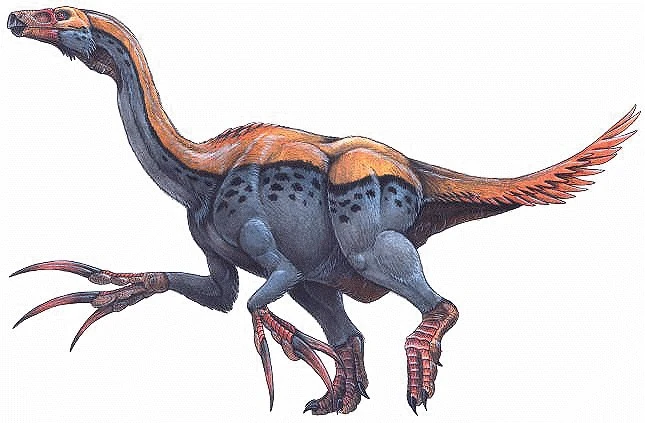Post by dinosauria101 on Jun 8, 2019 9:24:42 GMT 5
Giganotosaurus carolinii
Giganotosaurus ("giant southern lizard"), was a carcharodontosaurid dinosaur that lived 93 to 89 million years ago during the Turonian stage of the Late Cretaceous period. It is one of the longest known terrestrial carnivores, bigger than Tyrannosaurus, but in length and weight, smaller than Spinosaurus. Although longer than T. rex, G. carolinii was lighter and had a much smaller braincase that was the size and shape of a banana. A well-developed olfactory region means it probably had a good sense of smell. Titanosaur fossils have been recovered near the remains of Giganotosaurus, leading to speculation that these carnivores may have preyed on the giant herbivores. Fossils of related carcharodontosaurid fossils grouped closely together may indicate pack hunting, a behavior that could possibly extend to Giganotosaurus itself. he holotype specimen's (MUCPv-Ch1) skeleton was about 70% complete and included parts of the skull, a lower jaw, pelvis, hindlimbs and most of the backbone. The premaxillae, jugals, quadratojugals, the back of the lower jaws and the forelimbs are missing. Various estimates find that it measured somewhere between 12.2 and 13 m (40 and 43 ft) in length, and between 6.5 and 13.3 tons in weight. A second, more fragmentary, specimen (MUCPv-95) has also been identified, found in 1987 by Jorge Calvo. It is only known from the front part of the left dentary which is 8% larger than the equivalent bone from the holotype. This largest Giganotosaurus specimen is estimated to represent an individual with a skull length of 195 cm (6.40 ft), compared to the holotype's estimated at 1.80 m (5.9 ft) skull, making it likely that Giganotosaurus had the largest skull of any known theropod. Giganotosaurus surpassed Tyrannosaurus in mass by at least half a ton (the upper size estimate for T. rex is 9.1 t). Additionally several single teeth, discovered from 1987 onwards, have been referred to the species.

Therizinosaurus cheloniformis
Therizinosaurus is a genus of very large theropod dinosaurs. Therizinosaurus comprises the single species T. cheloniformis, which lived in the late Cretaceous Period (early Maastrichtian stage, around 70 million years ago), and was one of the last and largest representatives of its unique group, the Therizinosauria. Fossils of this species were first discovered in Mongolia and were originally thought to belong to a turtle-like reptile (hence the species name, T. cheloniformis – "turtle-formed"). It is known only from a few bones, including gigantic hand claws, from which it gets its name. Though the fossil remains of Therizinosaurus are incomplete, inferences can be made about their physical characteristics based on related therizinosaurids. Like other members of their family, Therizinosaurusprobably had small skulls atop long necks, with bipedal gaits and heavy, deep, broad bodies (as evidenced by the wide pelvis of other therizinosaurids). Their forelimbs may have reached lengths of up to 2.5 metres (8.2 feet) or even 3.5 metres (11.5 feet) in the largest known specimen. Their hindlimbs ended in four weight-bearing toes, unlike other theropod groups, in which the first toe was reduced to a dewclaw. In 2010 Gregory S. Paul estimated the maximum size of Therizinosaurus at 10 metres (33 ft) in length and five tonnes in weight. They are the largest therizinosaurs known, and the largest known maniraptorans. The most distinctive feature of Therizinosaurus was the presence of gigantic claws on each of the three digits of their front limbs. These were common among therizinosaurs but especially large in Therizinosaurus, and while the largest claw specimens are incomplete, they probably reached 0.7–1 metres (2.3–3.3 ft) in length. The claws are the longest known from any animal. The claws were relatively straight, only gradually tapering into a point, as well as extremely narrow and transversely flattened.

Credit to Wikipedia
Giganotosaurus ("giant southern lizard"), was a carcharodontosaurid dinosaur that lived 93 to 89 million years ago during the Turonian stage of the Late Cretaceous period. It is one of the longest known terrestrial carnivores, bigger than Tyrannosaurus, but in length and weight, smaller than Spinosaurus. Although longer than T. rex, G. carolinii was lighter and had a much smaller braincase that was the size and shape of a banana. A well-developed olfactory region means it probably had a good sense of smell. Titanosaur fossils have been recovered near the remains of Giganotosaurus, leading to speculation that these carnivores may have preyed on the giant herbivores. Fossils of related carcharodontosaurid fossils grouped closely together may indicate pack hunting, a behavior that could possibly extend to Giganotosaurus itself. he holotype specimen's (MUCPv-Ch1) skeleton was about 70% complete and included parts of the skull, a lower jaw, pelvis, hindlimbs and most of the backbone. The premaxillae, jugals, quadratojugals, the back of the lower jaws and the forelimbs are missing. Various estimates find that it measured somewhere between 12.2 and 13 m (40 and 43 ft) in length, and between 6.5 and 13.3 tons in weight. A second, more fragmentary, specimen (MUCPv-95) has also been identified, found in 1987 by Jorge Calvo. It is only known from the front part of the left dentary which is 8% larger than the equivalent bone from the holotype. This largest Giganotosaurus specimen is estimated to represent an individual with a skull length of 195 cm (6.40 ft), compared to the holotype's estimated at 1.80 m (5.9 ft) skull, making it likely that Giganotosaurus had the largest skull of any known theropod. Giganotosaurus surpassed Tyrannosaurus in mass by at least half a ton (the upper size estimate for T. rex is 9.1 t). Additionally several single teeth, discovered from 1987 onwards, have been referred to the species.

Therizinosaurus cheloniformis
Therizinosaurus is a genus of very large theropod dinosaurs. Therizinosaurus comprises the single species T. cheloniformis, which lived in the late Cretaceous Period (early Maastrichtian stage, around 70 million years ago), and was one of the last and largest representatives of its unique group, the Therizinosauria. Fossils of this species were first discovered in Mongolia and were originally thought to belong to a turtle-like reptile (hence the species name, T. cheloniformis – "turtle-formed"). It is known only from a few bones, including gigantic hand claws, from which it gets its name. Though the fossil remains of Therizinosaurus are incomplete, inferences can be made about their physical characteristics based on related therizinosaurids. Like other members of their family, Therizinosaurusprobably had small skulls atop long necks, with bipedal gaits and heavy, deep, broad bodies (as evidenced by the wide pelvis of other therizinosaurids). Their forelimbs may have reached lengths of up to 2.5 metres (8.2 feet) or even 3.5 metres (11.5 feet) in the largest known specimen. Their hindlimbs ended in four weight-bearing toes, unlike other theropod groups, in which the first toe was reduced to a dewclaw. In 2010 Gregory S. Paul estimated the maximum size of Therizinosaurus at 10 metres (33 ft) in length and five tonnes in weight. They are the largest therizinosaurs known, and the largest known maniraptorans. The most distinctive feature of Therizinosaurus was the presence of gigantic claws on each of the three digits of their front limbs. These were common among therizinosaurs but especially large in Therizinosaurus, and while the largest claw specimens are incomplete, they probably reached 0.7–1 metres (2.3–3.3 ft) in length. The claws are the longest known from any animal. The claws were relatively straight, only gradually tapering into a point, as well as extremely narrow and transversely flattened.

Credit to Wikipedia




